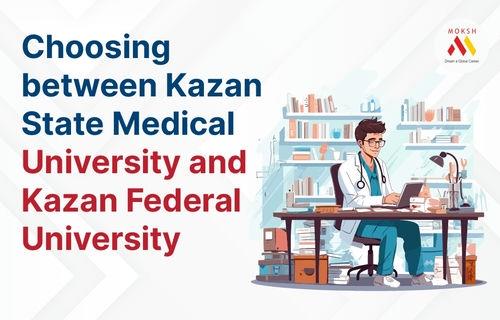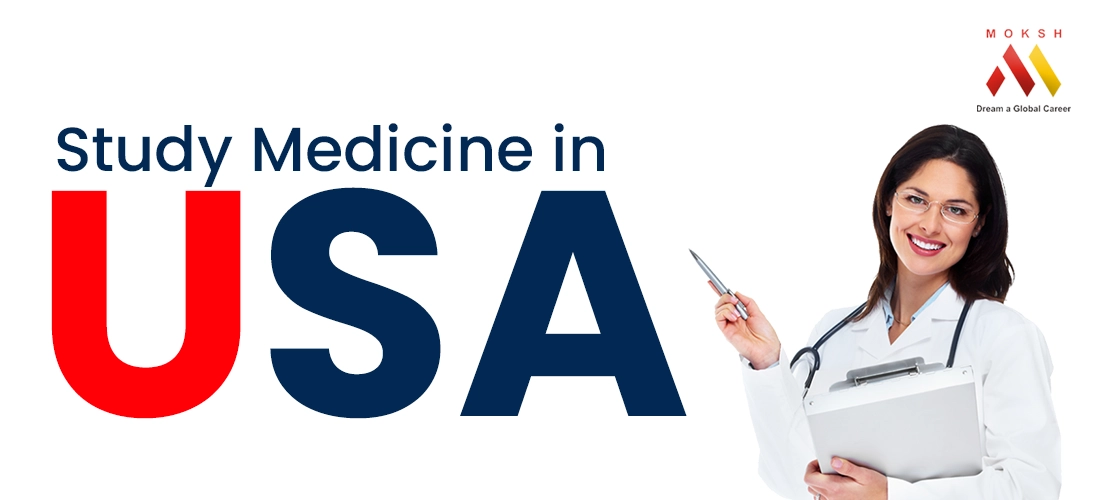
In 2023, approximately 9.5 Lacs active physicians are working in the United States, with individuals of Indian origin constituting around 8.5% of the entire physician community. Notably, India stands out as the most significant contributor of International Medical Graduates to the US in terms of absolute numbers. It is essential to understand that the journey of most of these Indian doctors is through Residency, not with an MD program in the US.
Pursuing a Medical education in the United States presents a formidable challenge. Yet, the journey proves to be rewarding for those with unwavering passion and a readiness to invest significant effort. Upon completion, graduates acquire the skills to help the needy, profoundly impacting lives—a pursuit that justifies the toil and perseverance.
For aspiring Medical students who are not US citizens or permanent residents, gaining admission to a US Medical school poses substantial difficulty. International students who relish aiding others and seeking new and challenging experiences might contemplate pursuing Medical studies in the US While the path is rigorous and lengthy, the gratification lies in the potential of securing a stable, well-paying job that commands pride.
MBBS in USA Vs MBBS in India
Both countries follow different Medical education systems to meet their countries' healthcare needs. Refer to the table below to understand the critical differences between MBBS in India and MBBS in the USA on a few parameters.
| Parameter | India | USA |
|---|---|---|
| Med Schools | 706 | 211 |
| College Type | Pub & Pvt | Pub & Pvt |
| MBBS seats | 1.04 Lakes | 20k |
| Tuition Fee for the course | Pub1-3 Lac Pvt 60 Lac - 1.5 Cr | Pub 2 Cr+ Pvt 3.5 Cr |
| Entrance Point | 10+2 | Bachelor (BS) |
| Entrance Exam | NEET MCQ Based | MCAT MCQ Based |
| Duration | 4.5+1 Years | BS 4 Yrs + MD 4 Yrs |
| Infrastructure | Good to Below Avg | Excellent |
| Clinical Rotations | 1 Year | 2 Yr of Core & Elective |
| Total Duration till PG | 4.5+1+3 Years | 4+4+3 to 5 Years |
Do US Medical schools accept international students?
In short, yes, but it's rare. International students, defined as those not holding green cards or permanent Residency, face more significant challenges in admissions due to limited consideration by US Medical Schools; some Medical admit and enroll a limited number of international applicants into Medicine courses in the US. Admission Policies and criteria regarding international applicants vary among Medical schools in the United States, making it crucial to verify each institution before applying. In 2023, 48 US Med Schools indicated they are open for applications from international candidates. You can explore individual Medical schools' admissions policies on their websites or within the "Application Deadlines and Requirements" section of the Medical School Admission Requirements.
In 2024, According to the Association of American Medical Colleges, out of around 20,000 available seats, close to 3,900 international students sought admission to MD programs in the US, with 325 applicants accepted in various Medical Schools in the US The Journey to Medicine in the US US for Indian Students is challenging.
Can Caribbean an alternative for US Med Schools
Every year, more than 200+ Indian students explore Caribbean Med Schools as an alternative route to US Med Schools; a handful join the reputed medical schools in the Caribbean with a proven track record, but the rest get trapped by agents for Poor infra Med Schools in the Caribbean. Read more about
What to Expect from Medical Schools in the USA
The duration of an MD course in US Medical school typically spans four years, followed by a 3 to 7-year Residency, providing supervised training in specialized fields. Those seeking additional training or specialization can opt for fellowships, extending training by 1 to 4 years.
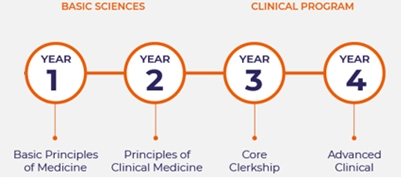
The educational journey towards becoming a doctor of Medicine in the demands US intensive, full-time dedication. The initial year involves significant memorization, encompassing anatomy, histology, pathology, and biochemistry courses. These classes blend classroom lectures with laboratory work, offering theoretical and practical insights into the human body. For instance, a typical gross anatomy class includes a lecture and several hours of dissecting cadavers or animals, facilitating a firsthand understanding of natural anatomical structures and functions.
As you progress in your Medical education in the USA, clinical rotations become increasingly frequent. These rotations enable hands-on patient interaction and provide insights into the potential career path as a doctor, intensifying as you near degree completion.
Before attaining a doctor of medicine degree in the US, passing the United States Medical Licensing Examination (USMLE) is mandatory. This exam, divided into three parts at various educational stages, ensures adherence to specific US educational standards.
Who is Right studying Medicine in the USA?
The decision to pursue Medical studies in the US is not for everyone due to the extensive duration, high costs, and overall challenges. Only students with a genuine passion for Medicine and a hunger for challenges should contemplate this path. The financial burden, especially in private colleges, can be substantially high. However, for those ready to tackle these challenges, studying Medicine in the US ensures access to some of the world's finest education for one of the most revered degrees.
Unlike the U.K., studying Medicine in the USA is exclusively available at a postgraduate level, allowing you to commence a Medicine program in the US after completing a four-year Pre-Medical degree in subjects such as Biology, Chemistry or Psychology. This undergraduate degree serves as preparation for the Medical College Admissions Test (MCAT), a mandatory requirement for admission into US Medical Schools.
Pre-Medical Course in U.S.
If you seek Pre-Med courses that establish a strong knowledge base for Medical school, several standard options stand out. While exploring your interests, consider the following programs:
- Biology: This remains a classic choice for pre-med students, focusing on the scientific study of all life forms on Earth. Declaring a major in biology offers advantages due to significant overlaps with the pre-med course track.
- Chemistry: Studying substances and their interactions has been a perennial favourite among pre-med majors. Chemistry majors engage in research and experiments to create beneficial compounds applicable to Medicine, energy, agriculture, and other fields.
- Psychology: This social science discipline delves into understanding the complexities of the human mind and behaviour, serving as a valuable asset for future physicians. It reinforces the significance of emotional intelligence and aids students in developing these crucial skills.
Top Medical Schools in the US
There are 211 Medical schools in the USA offering Doctor of Medicine or Doctor of Osteopathic Medicine (D.O.) degrees. When considering studying Medicine in the USA, the below can be considered as the Best Medical Universities in the US.
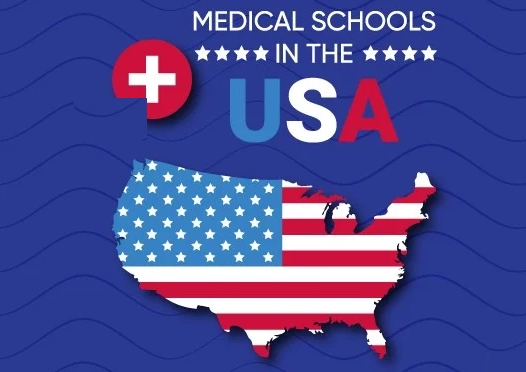
- Harvard University
- Stanford University
- Johns Hopkins University
- University of California
- University of Pennsylvania
- Washington University in St Louis
- Yale University
- Columbia University
- New York University
- University of Washington
Cost of Medicine Program in the U.S.
The expense of pursuing an M.D. in the USA for international students is primarily determined by tuition fees and additional expenditures related to studying there. Typically, the fee for an MBBS course in the USA ranges from $55,000 to $75,000 annually; the US Med Schools fee for Indian students comes out to 2 Cr to 3 Cr for a complete MD course in the US.
In addition to tuition, the overall cost of studying MBBS in the US for Indian students also encompasses living expenses such as accommodation, meals, transportation, books, and other essential items. These living expenses typically vary between $1,000 to $15,00 per month, depending on individual lifestyle & city of stay.
Entry requirements for studying Medicine in the U.S
Entry prerequisites vary among Medical schools, warranting verification from the respective institutions. Nevertheless, all U.S. Medical schools mandate the completion of a 4-year pre-med undergraduate degree in a relevant field and the demonstration of proficiency in scientific disciplines like Biology, General Chemistry and Organic Chemistry. Many students opt for Pre-Med programs in Biology or Chemistry to meet these criteria.
A commendable MCAT score is another critical requirement for pursuing Medicine in the USA, as it significantly influences acceptance into prestigious universities. The MCAT evaluates critical thinking, problem-solving abilities, and writing proficiency and measures knowledge of scientific concepts; taking the MCAT the year before intending to commence Medical studies is advisable. Hence, ensure timely registration for the MCAT exam to facilitate your journey into Medicine.
Aim for a score of at least 510 on the MCAT and a 3.8 GPA in the Pre Med Course as a good GPA and strong MCAT score significantly influence acceptance into prestigious Medical schools.
Min 2, Letter of Recommendations (LoR) from Teachers/Professors of your college
IELTS Score Overall Min 7 and, in each section, min 6.5
Application Process for US Med Schools
For most Medical schools in the U.S., applications are made using the American Medical College Application Service (AMCAS). AMCAS facilitates the submission of your application to your chosen Medical schools, including details of your work experience, coursework transcripts, extracurricular activities, and MCAT scores.
Some Medical schools may request supplementary materials like essays or letters of recommendation, known as a secondary application, often incurring an additional fee.
The AMCAS fee for applying to one Medical school is $160, with an extra $38 fee for each additional school added to your application. The Fee Assistance Program assists financially challenged students with these fees, including MCAT fees.
Applications generally open in early May and remain open until submission closure in June. Keeping track of the exact deadline is imperative to make sure to get it.
Shortlisted candidates by the selection committee will be interviewed by the Program Director, Finalized candidates will be offered for the Program.
About the MCAT Exam
The Medical College Admission Test or MCAT is a standardized, multiple-choice examination assessing problem-solving, knowledge of natural behaviour, critical thinking, and social science concepts for over 90 years. Annually, more than 85,000 students take this exam.
Introduced in April 2015, the current version of the MCAT exam comprises four sections:
- Biological and Biochemical Foundations of Living Systems
- Chemical and Physical Foundations of Biological Systems
- Psychological, Social, and Biological Foundations of Behavior
- Critical Analysis and Reasoning Skills
All U.S. and many Canadian Medical schools mandate MCAT scores for regular admission. Notably, numerous schools do not accept MCAT scores older than three years.
Where is the MCAT Exam Available?
The exam is offered multiple times a year in various locations across the United States and select international locations. There is no planned MCAT Exam centre in India in 2024. You need to travel to any of the international centres for MCAT exams like Australia, China, Hong Kong, France, Germany, Israel, Japan, Lebanon, Qatar, Singapore, South Africa, Taiwan, Thailand or the United Kingdom,
When Should I Take the MCAT Exam?
Before selecting an exam date, consider the possibility of needing a retake and your grasp of the content. Note that there are restrictions on testing frequency (three times in a calendar year, four times in two years, and seven times in a lifetime), and Medical schools receive all your scores. Ensure you take the exam when adequately prepared
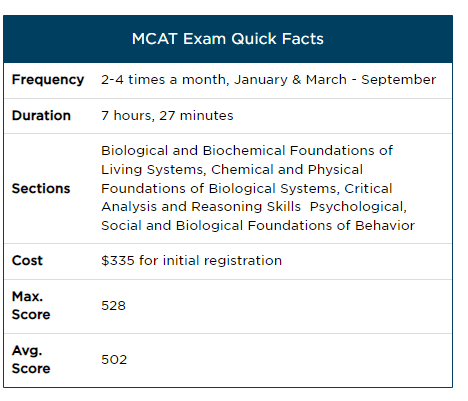
How is the MCAT Exam Scored?
Your MCAT exam yields five scores: one for each of the four sections and a combined total score.
Section scores: Each of the four scores ranges from 118 to 132.
Total score: A combined score from the four sections, ranging from 472 to 528.
Typically, scores are released 30–35 days after the exam date. For more information on your scores and score report, visit the relevant resources.

Paying for Medical school
Upon acceptance to a U.S. Medical school, officials may require substantial funds to be deposited into an escrow account, demonstrating the student's ability to cover educational costs. While this may be feasible for some students with parental financial support, it poses a significant challenge for many.
Each school has distinct policies; Certain institutions may necessitate pre-payment of tuition for the entire four-year program or establishing an escrow account for these funds. However, some schools might accept loans with a U.S. citizen as a consigner.
Financial Aid in US Med Schools Options:
International students cannot apply for U.S. federal funding, as only citizens and permanent residents are eligible for these loans, You can expect merit-based Scholarships in a few Med Schools in the US. Additionally, research-focused international applicants might explore joint M.D./PhD programs supported by their research mentor's grant.
Typically, international students need to secure private or institutional loans, if available, from the Medical school they plan to attend. International students should engage with their target schools' financial aid office and admissions staff to explore potential financing options.
P.G. Option after M.D. in the U.S.
After MBBS courses in the USA , IMGs have various options in the USA. They are passing USMLE and ECFMG certifications , which opens doors to Residency programs for specialized training (3-7 years). For even more profound expertise, fellowship programs offer 1-2 years of advanced training in subspecialties. Non-clinical paths include Master's programs in Public Health or Health Administration, research fellowships, and Medical writing/editing positions. Research your options, network with professionals, and prepare diligently for the USMLE to achieve your Medical career goals in the USA.
Courses After MBBS in USA Without USMLE : After completing MBBS, various non-USMLE pathways exist for further Medical training in the USA. Options include MPH in USA after MBBS or MHA in USA after MBBS (Master's programs in public health or health administration), specializing in biomedical research with MS, pursuing PhDs, rare fellowship programs, research fellowships, clinical research associate roles, and Medical writing and editing positions. All paths have distinct requirements, so research and contact programs directly for details. Medical Electives America: Medical electives in America offer valuable clinical, research, public health, and laboratory training for international medical graduates. Explore options through Medical schools, online platforms like VSLO and AMCAS, and conferences. Choose electives based on career goals, learning objectives, location, and program eligibility. Plan early and research programs thoroughly for a rewarding experience.
Medical PG in USA or Post graduation in Medical in USA : Choose from Residency, fellowship, or research programs. Applications are submitted through ERAS. Popular specialties include Internal Medicine, Surgery, and Pediatrics. Benefits include advanced training, diverse clinical experience, and career advancement. Challenges include a competitive application process, high costs, and visa regulations. Resources are available at ECFMG, USMLE, ERAS, and AMA websites. With careful planning and a strong foundation, IMGs can achieve their goal of becoming successful physicians in the USA. The cost of Medical PG in the USA is free.
An MBA after MBBS in the USA : An MBA after MBBS in the USA can propel your healthcare career. Benefits include leadership skills, higher income, diverse career paths, and improved business acumen. Requirements include a completed MBBS, strong academics, relevant experience, and compelling essays. Popular specializations include Healthcare Management, Pharmaceutical Management, and Health Informatics. Research programs, prepare for tests, gain experience, network, and seek guidance to maximize your chances of success. An MBA after MBBS can be a strategic move to unlock exciting career opportunities in the USA.







